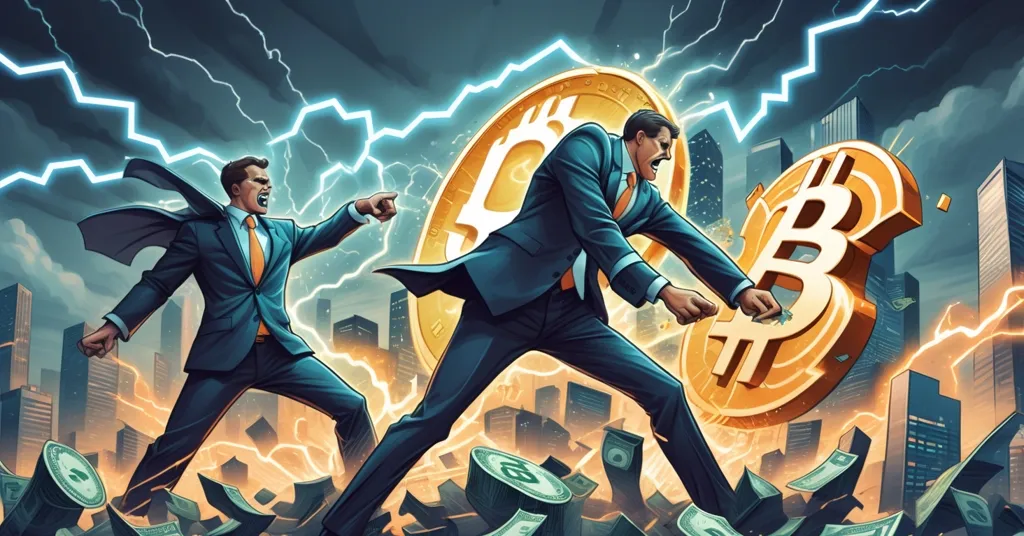Trump Targets Fed Chair Powell: Crypto Markets Brace for Impact

Trump’s War on Fed Chair Powell: A Shake-Up with Crypto Ripples
Donald Trump has dropped a bombshell, announcing his intent to replace Federal Reserve Chair Jerome Powell with former Fed governor Kevin Warsh, while aggressively pushing for a massive interest rate cut. This power play isn’t just a political spat—it’s a direct challenge to centralized financial control that could reverberate through the Bitcoin and crypto markets, highlighting why decentralization might be our best bet against such chaos.
- Trump targets Fed Chair Jerome Powell for replacement, frustrated by high interest rates.
- Kevin Warsh, a former Fed governor, emerges as a top pick to take over.
- A 1-percentage-point rate cut is Trump’s demand, despite strong economic indicators.
Trump vs. Powell: A Battle for Economic Control
From the confines of Air Force One, Donald Trump has made his stance clear: Jerome Powell’s days as Fed Chair are numbered. Trump’s frustration boils down to Powell’s refusal to slash interest rates, which he believes are strangling the U.S. economy with exorbitant borrowing costs. In a fiery Truth Social post, he declared,
“Very Simple!!! He is costing our Country a fortune.”
His proposed fix? A bold 1-percentage-point rate cut, which he hyped as
“Rocket Fuel!”
for economic growth. Trump’s impatience shines through with barbs like
“Too Late at the Fed is a disaster!”
as he zeroes in on the burden of
“debt that is coming due.”
This ongoing clash over interest rate policies has fueled controversy across financial circles.
For those new to the financial chess game, the Federal Reserve—often just called the Fed—is the U.S. central bank, tasked with managing the money supply and setting interest rates. Think of it as the thermostat for the economy: turn rates up to cool off inflation, or down to heat up growth through cheaper loans. Powell, as Chair, holds the reins on these decisions, affecting everything from your car loan to corporate debt. Learn more about his role and background here. Trump’s gripe is that high rates are making it expensive for the government and businesses to borrow, especially with the U.S. national debt hovering around $35 trillion as of recent estimates. He’s pointing to the European Central Bank’s recent quarter-point cut—their eighth since last June—as proof the Fed is lagging, even as U.S. job numbers shine with 139,000 new jobs added in May, per the Bureau of Labor Statistics, beating Dow Jones forecasts of 125,000.
Kevin Warsh: Trump’s Pick or a Policy Paradox?
Enter Kevin Warsh, Trump’s favored successor. A Fed governor from 2006 to 2011, Warsh earns high praise from Trump, who noted,
“He’s very highly thought of.”
Now a visiting fellow at Stanford’s Hoover Institution, Warsh carries a deep resume in monetary policy, having navigated the 2008 financial crisis. But here’s the rub—his track record leans toward tighter controls, not the aggressive stimulus Trump craves. Warsh has criticized the Fed for overstepping its core mission of price stability and employment, once stating, as reported by Reuters, that it “jeopardizes its ability to ensure stable prices and full employment” by meddling in broader societal issues. For a deeper look at his economic views, check this analysis on Warsh’s stance. During his tenure, he often resisted expansive policies, a stance that could clash with Trump’s push for cheap credit. Even more curious, the Wall Street Journal reports Warsh advised Trump to let Powell finish his term until May 2026, casting doubt on the urgency of this supposed ouster. Recent updates on his potential role can be found in this report.
So why Warsh? Trump might see him as a fresh face to shake up the status quo, but aligning their visions on rate cuts seems like trying to mix oil and water. For us watching from the crypto sidelines, Warsh’s skepticism of Fed overreach could hint at reluctance toward heavy-handed projects like central bank digital currencies (CBDCs), potentially leaving more room for blockchain innovation. But don’t bank on it—his traditionalist bent might also mean less tolerance for “wild west” financial experiments like crypto if they’re deemed risky. Some insights into how his policies could intersect with digital assets are explored here regarding Bitcoin.
Legal Roadblocks and Market Skepticism
Trump’s plan to boot Powell isn’t just a policy disagreement—it’s a direct assault on the Fed’s independence, a principle baked into its DNA since the days of the First and Second Banks of the United States. The Fed operates as a quasi-private entity, designed to shield monetary decisions from political whims. A recent Supreme Court ruling, covered by CNBC, reinforced this, labeling the Fed a “uniquely structured, quasi-private entity” with a “distinct historical tradition” that suggests strong protections against presidential meddling. Powell himself isn’t backing down, stating in November 2024 that Trump firing him is “not permitted under the law.” Justice Elena Kagan’s dissent in the ruling warned of the broader dangers of eroding such autonomy, a point that underscores the uphill battle Trump faces. More on this legal tension can be found in this detailed coverage.
Markets aren’t buying into Trump’s rate cut fantasy either. Analysts see virtually no chance of a cut at the next Federal Open Market Committee meeting, a far cry from the last 1-point slash in March 2020 during the COVID-19 panic. Even under Joe Biden’s final year, rate reductions came in cautious increments, not the reckless leap Trump demands. Adding fuel to the fire, Trump’s own tariff policies threaten inflationary spikes—something Powell has reportedly flagged as a concern, per Reuters. Market selloffs in April 2025, driven by fears of Fed interference and tariff chaos, show just how jittery investors are about this political circus. Trump’s bulldozing approach ignores these hard economic realities, risking a blowback that could dwarf any short-term “rocket fuel” gains. Public sentiment on this conflict is also heating up, as seen in discussions on social platforms.
Bitcoin and Crypto: Winners in Centralized Chaos?
For those of us in the Bitcoin and blockchain space, this Fed fiasco is more than a sideshow—it’s a glaring reminder of why centralized systems are a mess waiting to implode. Lower interest rates, if they ever happen, could drive speculative cash into cryptocurrencies, as cheap borrowing often fuels riskier bets. Historical data backs this: the Fed’s 2020 rate cuts correlated with Bitcoin’s surge past $20,000 by year-end, as investors chased higher returns outside stagnant fiat markets. Ethereum and other altcoins might also see inflows, especially for DeFi projects thriving on leveraged plays, though Bitcoin remains the unshakable store of value when trust in fiat falters. Curious about broader implications? Explore perspectives on the Fed’s potential influence on Bitcoin.
The Bigger Picture: Centralized Power vs. Freedom
Zooming out, Trump’s crusade against Powell isn’t just about interest rates—it’s a stark illustration of centralized power’s fragility. The Fed was built to stand apart from political puppet strings, yet here we are, watching a tug-of-war over who controls the money printer. For Bitcoin maximalists like many of us, this is the ultimate case for ditching fiat reliance. Why trust a system where one loudmouth can threaten decades of institutional separation? Even if Warsh steps in or Powell holds firm, the precedent of such interference erodes faith in traditional finance, pushing more toward permissionless, code-driven alternatives. Trump’s latest remarks on replacing Powell are covered in depth in this update.
Yet balance demands we acknowledge the flip side. The Fed’s independence, while flawed, has historically curbed rampant inflation and economic collapse—something Bitcoin’s wild swings can’t yet promise at scale. Altcoins like Ethereum fill niches with smart contracts and decentralized apps that Bitcoin doesn’t touch, proving the broader blockchain ecosystem has a role in this financial revolution. Still, as champions of disruption and effective accelerationism, we can’t ignore that every centralized misstep is a billboard for why decentralization matters. If political will can bend a central bank, isn’t it time we rethink who—or what—should define the value of money?
Key Questions and Takeaways
- Why does Trump want to replace Fed Chair Jerome Powell?
Trump blames Powell for keeping interest rates high, claiming it burdens the U.S. economy with costly borrowing and debt servicing, hindering growth. - What’s driving Trump’s demand for a 1-percentage-point rate cut?
He sees lower rates as a quick boost to cut debt costs and spur economic activity, citing the European Central Bank’s cuts as a model, despite solid job growth of 139,000 in May. - Who is Kevin Warsh, and does he match Trump’s economic goals?
Warsh, a former Fed governor from 2006-2011, is Trump’s top pick, but his preference for tighter monetary policy could conflict with Trump’s push for aggressive rate cuts. - Can Trump legally oust Powell given the Fed’s independence?
Legal protections, reinforced by a recent Supreme Court ruling, and Powell’s own defiance suggest Trump lacks the authority to fire him, facing significant institutional barriers. - How might this Fed drama impact Bitcoin and crypto markets?
Political interference in the Fed could boost Bitcoin’s case as a decentralized alternative, while rate cuts might spur crypto investment, though regulatory risks and market volatility loom. - What does this mean for the future of centralized finance vs. decentralization?
This clash exposes vulnerabilities in centralized systems, strengthening the argument for Bitcoin and blockchain as freer, trustless alternatives to politically swayed fiat structures.



